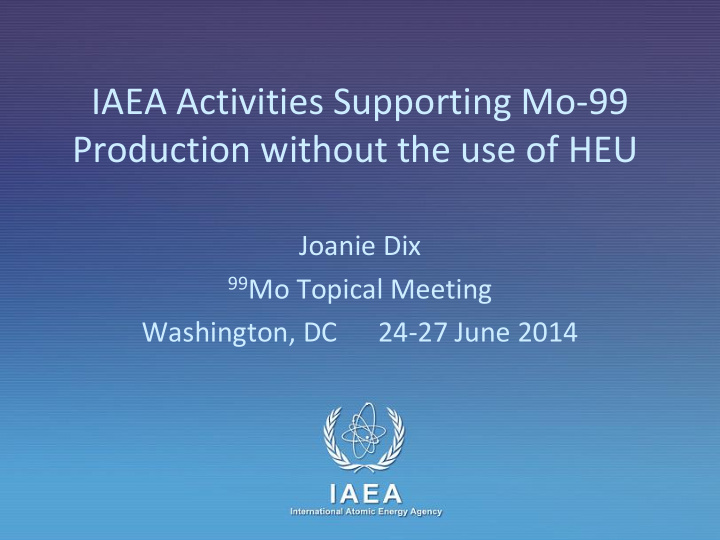



IAEA Activities Supporting Mo-99 Production without the use of HEU Joanie Dix 99 Mo Topical Meeting Washington, DC 24-27 June 2014 IAEA International Atomic Energy Agency
IAEA Organization for 99 Mo Work Office of the Director General Department of Department of Department of Department of Department of Department of Nuclear Science Technical Nuclear Safety and Management Nuclear Energy Safeguards and Applications Cooperation Security Division of Physical Division of Nuclear and Chemical Fuel Cycle and Sciences Waste Technology Radioisotope Nuclear Fuel Cycle Products and Waste Technology Research Reactor and Materials Radiation Section Section Section Technology Section IAEA 2
IAEA Priorities for 99 Mo HEU Minimization Stability of Supply Transition of 99 Mo Diversification of supply production away from the and movement to full cost use of highly enriched recovery to ensure the uranium (HEU) global demand is met IAEA 3
99 Mo IAEA Projects The IAEA can assist Member States in their 99 Mo work through various types of activities. These include: • Coordinated Research Projects • Technical Cooperation Projects • Regular program activities • Networks and coalitions • Participation in complimentary, international activities • Meetings • Missions • Publications • General Conference side-events IAEA 4
Conversion of Major 99 Mo Producers to LEU • Supported by US DOE-NNSA and the Government of Norway • Series of working group meetings for key stakeholders to review progress, exchange information and explore opportunities for mutually beneficial collaboration • Receiving updates on LEU high-density targets, and accompanying chemical processes • Most recent meeting took place 27-28 January 2014 IAEA 5
Small-scale, non-HEU 99 Mo production • Draft publication on Feasibility of Small-Scale 99 Mo Production using LEU Fission or Neutron Activation Methods • In final review now; scheduled for publication in 2014 • Incorporates the results of the Coordinated Research Project on small-scale production (2005-2011) IAEA 6
Small-scale, non-HEU 99 Mo production • Technical Cooperation Project started in 2013 • Aimed at assisting small-scale, national-level producers in setting up their production capability; • NOT aimed at creating commercial producers • Will rely on LEU fission or n,gamma-based production • Open to any IAEA Member States wishing to receive advice and assistance • Production infrastructure fact-finding missions were completed to Mexico, Morocco, Peru, Poland, and Romania. Similar missions were conducted in Egypt (2010) and Malaysia (2011) IAEA 7
Small-scale, non-HEU 99 Mo production • Expert Missions • 99 Mo production project progress review missions • Production infrastructure readiness missions • IAEA and project counterpart missions to 99 Mo production facilities and laboratories • EURASIA Coalition work • Reactors in Eastern Europe and former Soviet states cooperating to produce low specific activity 99 Mo via neutron capture of 98 Mo (launched in 2008) IAEA 8
Full Cost Recovery & Managing 99 Mo Waste Streams • Intended to study technical and economic aspects of 99 Mo waste streams in cooperation with the OECD-NEA • Work on this study was halted due to the low response rate (<50%) • Without this information, the study would not have the necessary data to contribute any meaningful analysis IAEA 9
Coordinated Research Project on Accelerator-based Alternatives to Non-HEU Production of 99 Mo/ 99m Tc IAEA International Atomic Energy Agency
Participating Countries • ARMENIA • BRAZIL • CANADA • HUNGARY • INDIA • ITALY • JAPAN • KINGDOM OF SAUDI ARABIA • POLAND • SYRIA • UNITED STATES IAEA 11
Alternative Routes to 99 Mo/ 99m Tc Production 100 Mo(p,pn) 99 Mo 100 Mo( ,n) 99 Mo 99 Mo (T 1/2 = 66 h) 98 Mo(n, ) 99 Mo 100 Mo(n,2n) 99 Mo 100 Mo(p,2n) 99m Tc 98 Mo(d,n) 99m Tc 99m Tc (T 1/2 = 6 h) 98 Mo(p, ) 99m Tc IAEA 12
Cyclotron Production of 99m Tc 99m T c 101 Tc p n 100 Mo n 100 Mo(p,2n) 99m Tc IAEA 13
Cyclotron Production of 99m Tc 100 Mo(p,2n) 99m Tc Target Irradiation Radionuclide Processing Separation IAEA 14
Main issues • Target preparation (withstand heat generated by the beam) • Radionuclidic separation Mo/ 99m Tc: fast and high yield • Recovery of the target: enriched and high cost • Radionuclidic impurity: choose optimum beam energy, time of irradiation and decay time; select the target carefully! • Delivery of 99m Tc IAEA 15
Radionuclidic Impurities 100,9x Mo(p,2n) 9x Tc series 97g Tc 99g Tc 95g Tc 94g Tc 93g Tc IAEA 16
Radionuclidic Impurities IAEA 17
Conclusions Optimized Production Conditions • Target enrichment: 99.05 % • Proton Energy Window: 15 > Ep > 20 MeV • Irradiation Time: < 3 hours • Proton Current: 400 A • In-Target Yield: 6 Ci IAEA 18
Points of Contact • Nuclear Energy – Research Reactor Section J.Dix@iaea.org E.Bradley@iaea.org • Nuclear Science & Applications – Radioisotope Products and Radiation Technology Section J.A.Osso-Junior@iaea.org M.Venkatesh@iaea.org IAEA 19
Recommend
More recommend